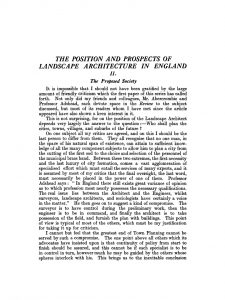The LI President discussed the importance of looking back, as well as forward
Our new President, Merrick Denton-Thompson, gave an inspiring Christmas lecture to the LI London branch on 14 December 2016. His subject was Landscape Architecture: Past, Present and Future. I am grateful that he agreed to my publishing the video on the Landscape Architects Association website.
The first part of the lecture was about the importance of Heritage Land status to Highclere Castle, also known as Downton Abbey. Opening the Capability Brown park to public use saved the owner a large tax bill and delivered a significant public good. In history, theory and practice, the public good is at the heart of our profession.
A landscape architect friend of mine was shocked by the photograph on the cover of the June 1994 edition of Landscape Design that depicted the M3 slicing through Twyford Down. He saw it as a symbol of landscape architects serving as hand-maidens for the development lobby, as we often do. But our President’s Christmas lecture tells a very different story. Fighting engineers, lawyers, politicians and his own employer, Merrick – then the chief landscape architect for Hampshire County Council – decided that he ‘had to take private action against the Department of Transport’.
In Twyford Down: Roads, campaigning and environmental law, Barbara Bryant explained that ‘The possibility of having to sell one’s house to pay costs concentrates the mind. It is a risk which only the most committed and determined individuals will be prepared to take. Such were the individuals, Barbara Bryant, David Croker and Merrick Denton-Thompson, in whose name the Twyford Down Association’s High Court application was actually brought’. The campaigners won their case with the European Commission, but were defeated by a late-night stitch-up between Jacques Delors and John Major that saw the UK exempted from the EIA Directive, based on the ugly principle that the EU’s reputation is more important than the rule of law.
After 21:29 in the video, Merrick turns to consider ‘the landscape profession tomorrow’. Below are the key points, with comments from me in italics.
- The LI’s job is ’empowering the membership to deliver public goods’. This is exactly right. The LI is not an environmental charity that collects money on street corners and spends it on good causes; it is first and foremost a membership body.
- The LI needs to ‘align the Board of Trustees with the Advisory Council’ so that ‘the Board of Trustees is making decisions that have been market-tested’. This would be a positive step. In recent years, many members have felt that the Advisory Council has been sidelined.
- The LI has ‘made a big strategic decision about broadening the membership’. This began 40 years ago, when we changed from the Institute of Landscape Architects (ILA) to the LI, but then nothing happened and many other organisations have stepped in. Now, ‘if we don’t take action, we are going to be boxed into a very small space’. The ‘problem of the divisions‘ must be resolved. My preferred solution is the establishment of interest groups within the LI to promote different specialisms and policy areas: design, design theory, management, science, assessment, planning, ecology, education, health, national parks, green belt, skyline policy, housing, urban food production, SuDS, climate change, and so forth. These groups could operate in a similar way to ASLA‘s Professional Practice Networks.
- We do not have ‘the balance between the arts and the sciences’ right. This includes the social sciences, as well as the biological sciences. I agree: landscape architecture lacks strength in the natural and the social sciences, as well as in the fine arts.
- Our profession has ‘haemorrhaged’ from the public sector and this is ‘really, really serious’. This is as sad as it is true. In part, the explanation is that the landscape profession has not said enough about its role in creating places for public benefit. LI support for the landscape planning specialism would help remedy this, as would an updated policy statement on roads to follow the 1946 report on Roads in the landscape.
- ‘We need political leadership and we need the infrastructure in the civil service for us to get anywhere in terms of policy and commitment.’ I agree.
- ‘We need to re-position what we are doing to master planning. So I am really keen on developing landscape planning and, in fact […] a lot of [practices] are changing their titles to planning. […] We need to be the master planners. The architects will do as they’re told.’ Good design is vital, but without good planning it can be a waste of landscape architects‘ time and their clients‘ money.
- ‘The debate in the Select Committee [on parks] was: should there be a statutory obligation on local government to provide and manage parks and urban spaces? This is an important debate for us.’ Landscape architects should be more involved in managing public parks, as well as in planning and designing the public realm.
- On modernising the green belt: ‘I think this is our business. I don’t think it is planning business any more. […] It’s been white land. There has been nothing positive about the green belt. […] It is dysfunctional.’ I agree that landscape architects need to be involved in managing the green belt. But I am concerned that the word ‘modernise’ implies on emphasis on commercial development rather than public goods and natural capital.
- ‘Brexit is a fabulous opportunity for us as a profession. […] The UK wrote most of the EU’s environmental directives and I am 100% certain that the vote for exiting Europe had nothing to do with dismantling environmental legislation. […] I’m an optimist, and one of the opportunities is for us to have a multi-functional countryside.’ However you voted in the referendum, this is true for our profession.

Since it is of fundamental importance to landscape architecture, I will end my commentary by thanking our new president for his broad, deep and wise commentary on what the man who became our first president – T.H. Mawson – wrote in 1911. Mawson’s article The position and prospects of landscape architecture in England predates the ILA by 18 years and, though good, is insufficiently Geddesian. Mawson was more concerned with the professional than the theoretical: who should do the work, rather than what work should be done. Merrick has righted the balance. I would like to hear each new LI president address this topic, following Mawson and Merrick’s example by setting out their vision for the future and relating it to the past.
Thomas Mawson and Patrick Geddes were two of the first UK citizens to use ‘landscape architect’ as a professional title in its current sense. We owe them a debt of thanks for a role that gave Merrick ‘the most exciting public sector life’.
‘We are in a really exciting profession,’ he remarked, ‘at the interface of natural systems and people.’




